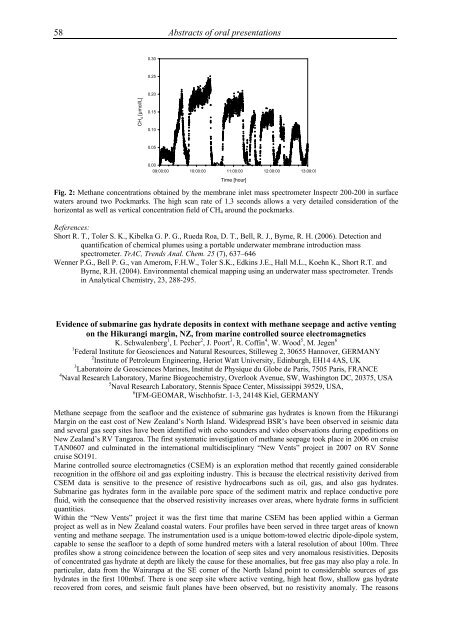Ninth international conference on - Marum
Ninth international conference on - Marum
Ninth international conference on - Marum
Create successful ePaper yourself
Turn your PDF publications into a flip-book with our unique Google optimized e-Paper software.
58<br />
CH 4 [µmol/L]<br />
0.30<br />
0.25<br />
0.20<br />
0.15<br />
0.10<br />
0.05<br />
Abstracts of oral presentati<strong>on</strong>s<br />
0.00<br />
09:00:00 10:00:00 11:00:00 12:00:00 13:00:00<br />
Time [hour]<br />
Fig. 2: Methane c<strong>on</strong>centrati<strong>on</strong>s obtained by the membrane inlet mass spectrometer Inspectr 200-200 in surface<br />
waters around two Pockmarks. The high scan rate of 1.3 sec<strong>on</strong>ds allows a very detailed c<strong>on</strong>siderati<strong>on</strong> of the<br />
horiz<strong>on</strong>tal as well as vertical c<strong>on</strong>centrati<strong>on</strong> field of CH4 around the pockmarks.<br />
References:<br />
Short R. T., Toler S. K., Kibelka G. P. G., Rueda Roa, D. T., Bell, R. J., Byrne, R. H. (2006). Detecti<strong>on</strong> and<br />
quantificati<strong>on</strong> of chemical plumes using a portable underwater membrane introducti<strong>on</strong> mass<br />
spectrometer. TrAC, Trends Anal. Chem. 25 (7), 637–646<br />
Wenner P.G., Bell P. G., van Amerom, F.H.W., Toler S.K., Edkins J.E., Hall M.L., Koehn K., Short R.T. and<br />
Byrne, R.H. (2004). Envir<strong>on</strong>mental chemical mapping using an underwater mass spectrometer. Trends<br />
in Analytical Chemistry, 23, 288-295.<br />
Evidence of submarine gas hydrate deposits in c<strong>on</strong>text with methane seepage and active venting<br />
<strong>on</strong> the Hikurangi margin, NZ, from marine c<strong>on</strong>trolled source electromagnetics<br />
K. Schwalenberg 1 , I. Pecher 2 , J. Poort 3 , R. Coffin 4 , W. Wood 5 , M. Jegen 6<br />
1 Federal Institute for Geosciences and Natural Resources, Stilleweg 2, 30655 Hannover, GERMANY<br />
2 Institute of Petroleum Engineering, Heriot Watt University, Edinburgh, EH14 4AS, UK<br />
3 Laboratoire de Geosciences Marines, Institut de Physique du Globe de Paris, 7505 Paris, FRANCE<br />
4 Naval Research Laboratory, Marine Biogeochemistry, Overlook Avenue, SW, Washingt<strong>on</strong> DC, 20375, USA<br />
5 Naval Research Laboratory, Stennis Space Center, Mississippi 39529, USA,<br />
6 IFM-GEOMAR, Wischhofstr. 1-3, 24148 Kiel, GERMANY<br />
Methane seepage from the seafloor and the existence of submarine gas hydrates is known from the Hikurangi<br />
Margin <strong>on</strong> the east cost of New Zealand’s North Island. Widespread BSR’s have been observed in seismic data<br />
and several gas seep sites have been identified with echo sounders and video observati<strong>on</strong>s during expediti<strong>on</strong>s <strong>on</strong><br />
New Zealand’s RV Tangaroa. The first systematic investigati<strong>on</strong> of methane seepage took place in 2006 <strong>on</strong> cruise<br />
TAN0607 and culminated in the <str<strong>on</strong>g>internati<strong>on</strong>al</str<strong>on</strong>g> multidisciplinary “New Vents” project in 2007 <strong>on</strong> RV S<strong>on</strong>ne<br />
cruise SO191.<br />
Marine c<strong>on</strong>trolled source electromagnetics (CSEM) is an explorati<strong>on</strong> method that recently gained c<strong>on</strong>siderable<br />
recogniti<strong>on</strong> in the offshore oil and gas exploiting industry. This is because the electrical resistivity derived from<br />
CSEM data is sensitive to the presence of resistive hydrocarb<strong>on</strong>s such as oil, gas, and also gas hydrates.<br />
Submarine gas hydrates form in the available pore space of the sediment matrix and replace c<strong>on</strong>ductive pore<br />
fluid, with the c<strong>on</strong>sequence that the observed resistivity increases over areas, where hydrate forms in sufficient<br />
quantities.<br />
Within the “New Vents” project it was the first time that marine CSEM has been applied within a German<br />
project as well as in New Zealand coastal waters. Four profiles have been served in three target areas of known<br />
venting and methane seepage. The instrumentati<strong>on</strong> used is a unique bottom-towed electric dipole-dipole system,<br />
capable to sense the seafloor to a depth of some hundred meters with a lateral resoluti<strong>on</strong> of about 100m. Three<br />
profiles show a str<strong>on</strong>g coincidence between the locati<strong>on</strong> of seep sites and very anomalous resistivities. Deposits<br />
of c<strong>on</strong>centrated gas hydrate at depth are likely the cause for these anomalies, but free gas may also play a role. In<br />
particular, data from the Wairarapa at the SE corner of the North Island point to c<strong>on</strong>siderable sources of gas<br />
hydrates in the first 100mbsf. There is <strong>on</strong>e seep site where active venting, high heat flow, shallow gas hydrate<br />
recovered from cores, and seismic fault planes have been observed, but no resistivity anomaly. The reas<strong>on</strong>s














